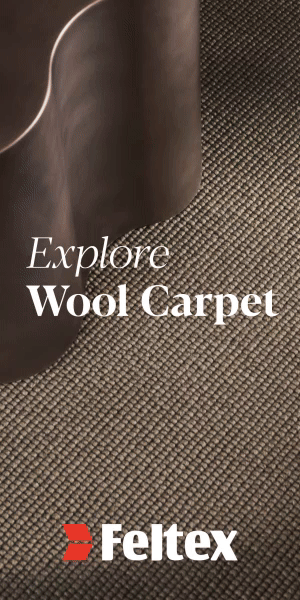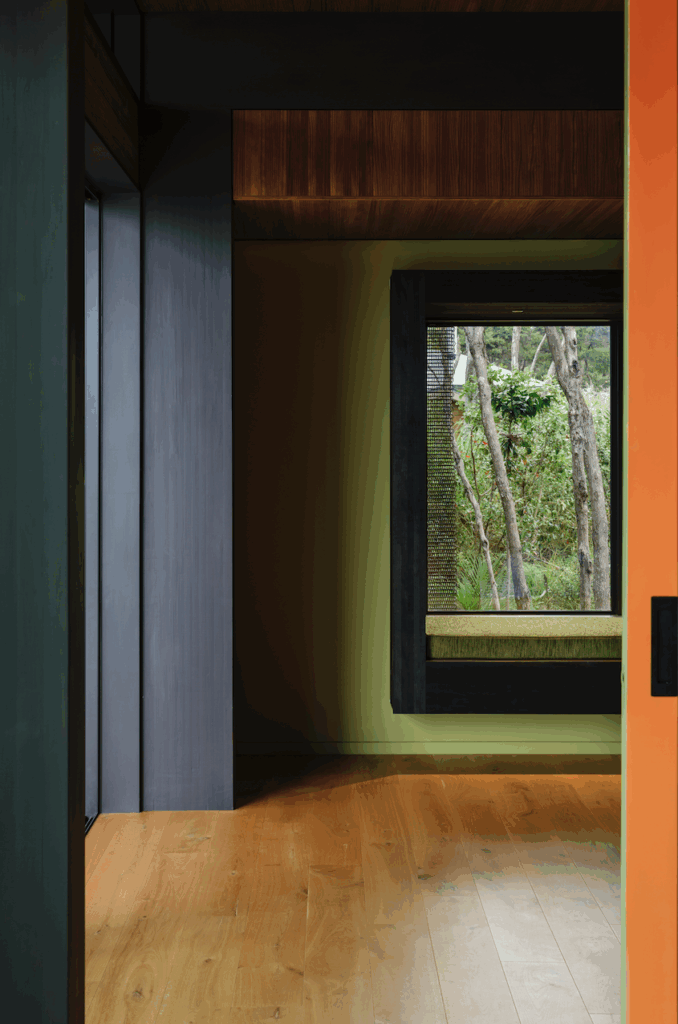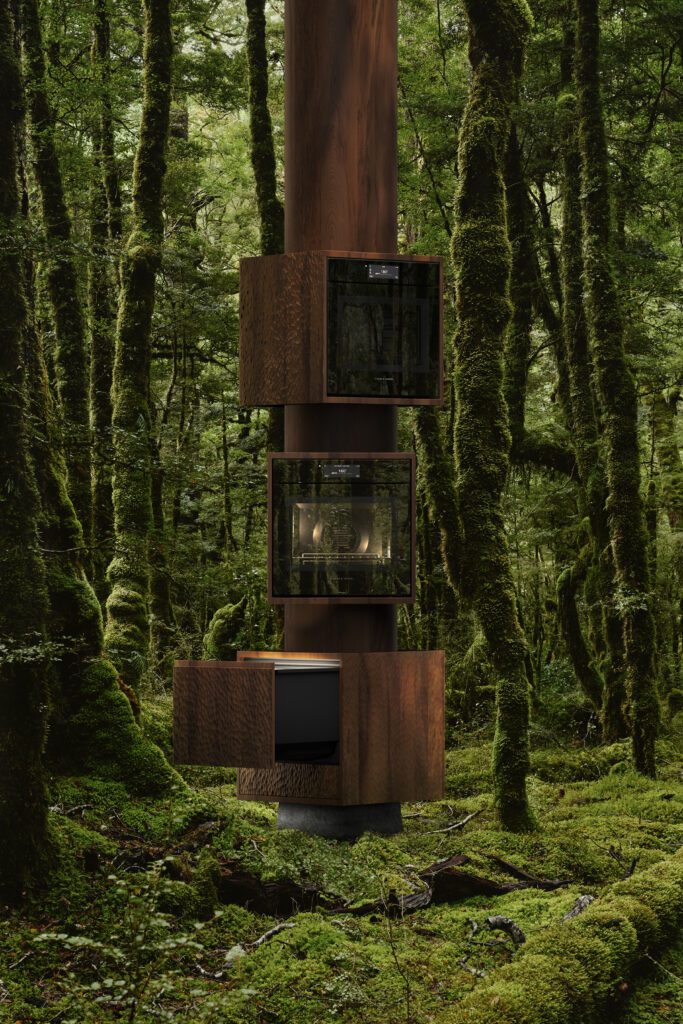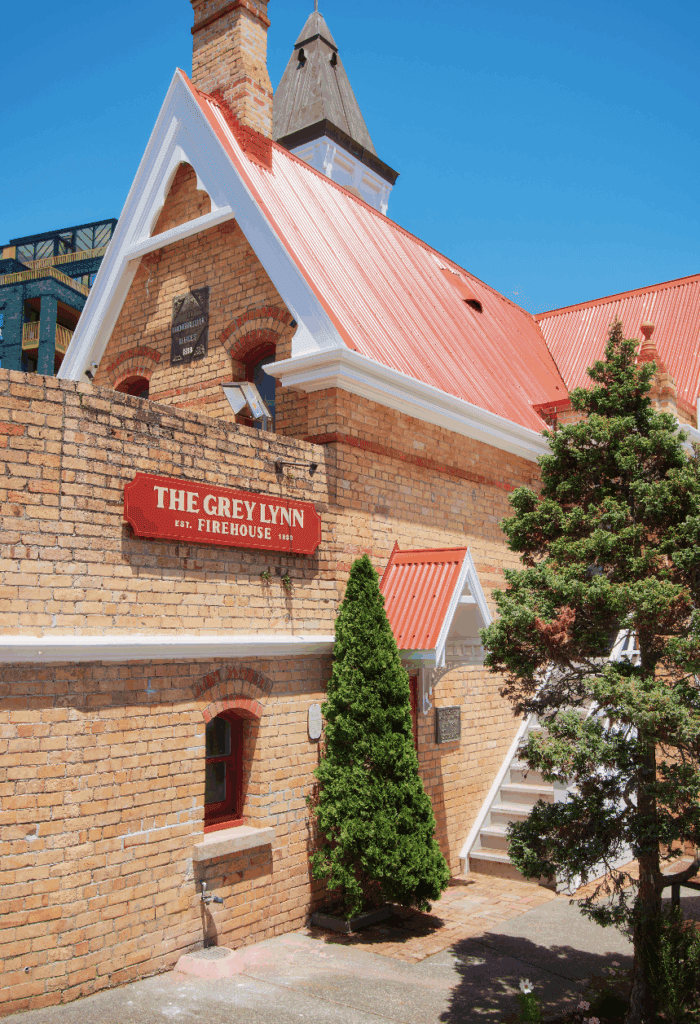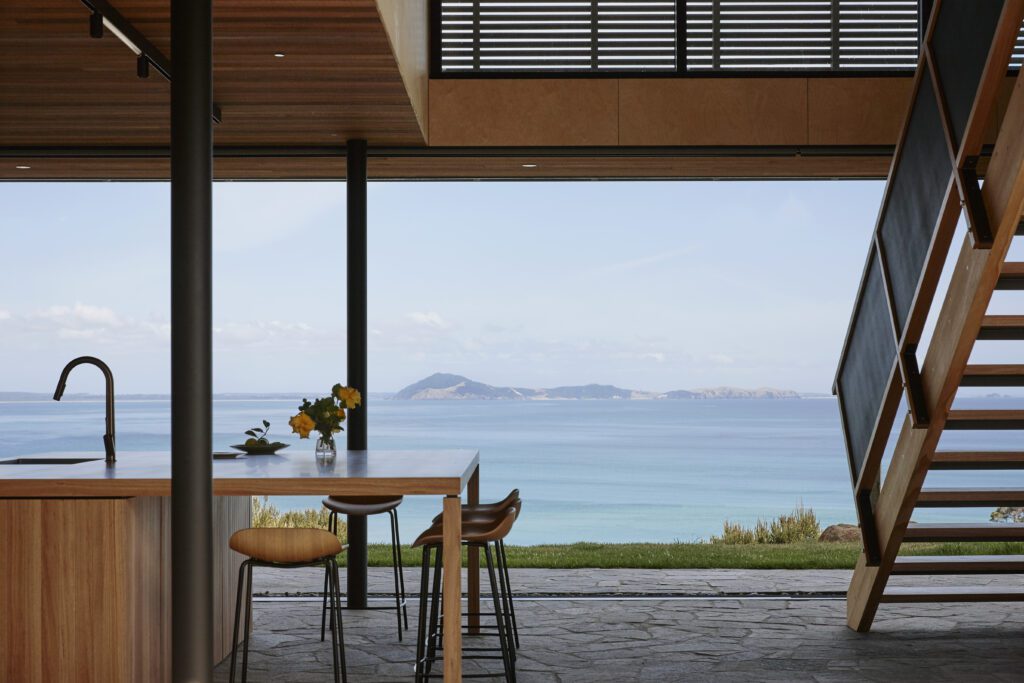Modernist proportions and a dramatic cantilever work in tandem to lend gravitas and lightness to this Hawke’s Bay home by Daniel Marshall Architects.

There is a fleeting moment when a nesting tākapu — the Australiasian gannet that lends its te reo name to this project — senses a wind current and lifts its wings as if to savour its strength and direction. Its long, slender pinions with black tips expand, wobble, and adapt to the breeze.
To any observer, there is an element of tension there, as it is unclear whether the bird will be lifted or stay put, and how that current might carry it past its habitat along the cliff’s edge. It is that moment — that quick battle between gravity and lift-off — that architect Daniel Marshall wanted to encapsulate in the design of a home that sits just below the ridge on a cliff overlooking Ocean Beach in Hawke’s Bay.
“The way the house is sited,” says Daniel, “means that it is following the contour of the land for the first half, but then the contour drops away underneath it.”

This is a house of levity and solidity, as orchestrated by a dramatic view of the Pacific. “The ‘reveal’ as you approach the home by car is fabulous,” write the owners. “At a single glance, you see the cantilever, and look right through the living room to the ocean below and beyond.”
Will the house fly, or stay nesting in its place? Daniel comments that it would have been easier to place the abode higher up towards the ridge, or it would have been more dramatic to fully cantilever it over the cliff’s edge. However, by emulating the gannet’s prudence, and burrowing slightly, the east-facing home allows for the prevailing southwesterlies to flow over the roof, buffered by its less used façade.

“It’s a real Glenn Murcutt thing,” says Daniel about the Pritzker prize–winning Australian architect known for ‘touching the earth lightly’. “The more sensitive intervention is to pull back a bit and try and fit in with the context.” “We particularly love the way the home sits gently within its environment — it doesn’t compete with the ocean,” say the owners.
The arrival is a solid affair: a swooping driveway delivers you onto a cocoon of cedar — garaging to the right, a deck preamble to the entrance directly ahead — while an enormous Moreton Bay fig speckles everything with dappled sunlight.
The material palette is simple and immediately readable. The architect recalls a childhood memory as its impetus.
“My dad lived in Hawaii on the North Shore of O‘ahu and there was a trade wind,” he says, describing the warm and humid currents that carry sea salt across coastal locations, “so everything that wasn’t cedar or copper was destroyed!”
So, to befit this dramatic coastal location, timber, concrete, glazing, and copper guttering have been stitched together.

One thing that becomes apparent early on is the delicate proportions of the roof.
“A very talented guy in our office kept trying to figure out how to create that thinness,” says Daniel. The solution is what he calls ‘an optical illusion’, achieved by keeping the edging of the roof elegant, and seeking to group all the thicker roofing needs further from the edge.
“It is a nice rectangular section gutter. The eaves angle up from underneath, and they angle down into the gutter on the roof side. It’s a membrane roof that has been really built up in the middle, where you need the structure and everything else, but then we’ve just tapered it down, trying to make it look as if it’s just a very fine wing.”

This elegant thinness contributes greatly to the quintessentially modernist form of the abode.
“The modernist thing is interesting,” explains the architect, “because the idea of a pavilion or a glass box is fun, but how do you do that in a way that’s not creating a terrible environment inside, and without huge amounts of mechanical intervention?”
He mentions that the owners, despite temperatures easily reaching the mid 30s here during summer, didn’t install air conditioning — a move that made him “a little nervous”.
“Apart from living in Asia for a few years, we’ve never really enjoyed the concept of completely closing up our home to the environment during summer, switching on the air-con, then only experiencing the world through glass,” write the owners.
“[It is] far better, in our view, to be living amongst the Hawke’s Bay environment rather than in an unnatural (and expensive) one inside. That said, we did recognise that, with so much glazing, and the searing temperatures of Hawke’s Bay summers, excessive heat in the home posed a comfort risk.”

To compensate, the architect went back to a cross-draft technique he used in his 2021 Mahuika House on Waiheke Island. The idea was to have sliding doors on both east and west elevations that could be opened at the same time.
“Because there’s always some breeze by the water, it will suck the [hot] air out of all the nearby living areas,” says Marshall.
“We’ve found that this has mitigated any heat concerns and only adds to the relaxed feeling we had hoped for when living in the home,” say the owners. “So, in totality, more workload [is needed] to keep the home comfortable in warm weather than just flicking an air-con switch, but it’s also significantly more pleasant and sustainable.”
The interior uses the same materiality as the exterior, but in slightly more finely crafted ways.
“[The architect] had started the canvas with the cedar ceilings, wall colour, concrete floor and walls, ECC lighting plan, and glazing,” say the owners. “Our job was to complete that with the built-in and stand-alone furniture, kitchen, bathrooms, and soft furnishings. We sought to have a home that was contemporary yet relaxing, light-filled, uncluttered, and in keeping with its beach environment.”

For the kitchen, they adapted a design they had developed in a previous, city home.
“Basically, just making it bigger, using Polaris Matt panels to deliver a really smooth and velvety touch, plus a single sheet of 8mm stainless steel for the island benchtop. Again, elegant and functional without being excessive in the beach environment.”
In the bathrooms, the materiality of the exterior was continued with the use of concrete for the vanities, “softened with light timber for the cabinetry and natural-coloured, oversized finger tiles,” according to the owners.
There is a rhythmic pace to the various openings along the gallery hall, which include a window that goes from the floor up to knee height.
“Compositionally, it is really nice to have these sorts of moments,” says Daniel of this peculiar window. “At first, we had vertical windows, and it was a little bit too formal.” This lower light ingress complements the relaxed feel of the interior, leaves more wall space for the owners’ art, and grants privacy from the arrival sequence.

The living room is the most dramatic, taking this idea of a gannet about to fly to its maximum expression. To achieve this, the architect pushed the living areas onto the cantilever that juts above a small storage space (for water tanks and an ATV to drive down to the beach).
Notoriously complex, a cantilever can also be prohibitively expensive. The architect credits a simple move — making the supporting columns round rather than the usual square — as the solution to enabling the proposition to work here.
“You can run the down pipes within those [posts], [so] a much simpler structural system was needed.”
“In the depths of winter, it’s an extremely robust home — warm and protective against the gales and storms rolling in over the ocean below,” say the owners. “There’s no better feeling than sitting cocooned near the windows with the fire crackling, watching the weather show unfold.”
Project Credits
Architecture: Daniel Marshall Architects
Build: Richard Kepka Builders
Words: Federico Monsalve
Images: Paul Ross Jones
Roofing: Nuralite
Concrete Sealer: PeterFell
Lighting: ECC
